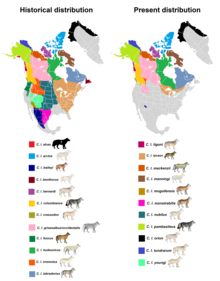| Bernard's wolf | |
|---|---|
| Conservation status | |
 Extinct (early 1900s) (IUCN 3.1) | |
| Scientific classification | |
| Domain: | Eukaryota |
| Kingdom: | Animalia |
| Phylum: | Chordata |
| Class: | Mammalia |
| Order: | Carnivora |
| Family: | Canidae |
| Genus: | Canis |
| Species: | C. lupus |
| Subspecies: | †C. l. bernardi |
| Trinomial name | |
| †Canis lupus bernardi Anderson, 1943 | |

| |
| Historical and present range of gray wolf subspecies in North America | |
| Synonyms | |
| |
Bernard's wolf (Canis lupus bernardi), also known as the Banks Island wolf or the Banks Island tundra wolf, is an extinct subspecies of the gray wolf that was limited to Banks and Victoria Island of the Arctic Archipelago.
Taxonomy
It is recognized as a subspecies of Canis lupus in the taxonomic authority Mammal Species of the World (2005). It was formally discovered, classified, and named after Peter Bernard, sailing master of the gas schooner Mary Sachs of the Canadian Arctic Expedition and collected four other specimens of Canis Lupus Bernardi, and Joseph F. Bernard, his nephew, who made voyages into the Arctic as master of the gas schooner Teddy Bear, after an adult male skin and skull was collected by them and brought to the National Museum of Canada. There were very few specimens of the subspecies that were recovered, around three or four in total.
Description
The wolf was described as "white with black-tipped hair along the ridge of the back". It is a large rangy wolf, with long narrow skull, slender rostrum and extremely large upper and lower carnassials.
Extinction
A survey was conducted in March 1993 by the Department of Renewable Resources that was to catalog the wolf and caribou populations of the area. While a number of caribou were found and recorded, along with many other indigenous animal species, not a single wolf was found. The Victoria Island population is believed to have become extinct between 1918 and 1952, with one source proposing around 1920.
References
- Wozencraft, W. C. (2005). "Order Carnivora". In Wilson, D. E.; Reeder, D. M. (eds.). Mammal Species of the World: A Taxonomic and Geographic Reference (3rd ed.). Johns Hopkins University Press. pp. 532–628. ISBN 978-0-8018-8221-0. OCLC 62265494.
- "Elsevier's dictionary of mammals: in Latin, English, German, French and Italian" - Google Books
- ^ "The Eponym Dictionary of Mammals" - Google Books
- Wozencraft, W. C. (2005). "Order Carnivora". In Wilson, D. E.; Reeder, D. M. (eds.). Mammal Species of the World: A Taxonomic and Geographic Reference (3rd ed.). Johns Hopkins University Press. pp. 575–577. ISBN 978-0-8018-8221-0. OCLC 62265494. url=https://books.google.com/books?id=JgAMbNSt8ikC&pg=PA576
- "Bernard, P. and J.", The Eponym Dictionary of Mammals by Bo Beolens, Michael Watkins and Michael Grayson, JHU Press, 2009, Pg. 40
- "Wolf Empire: An Intimate Portrait of a Species" - Google Books
- Anderson, Rudolph (1943). "Summary of the Large Wolves of Canada, with Description of Three New Arctic Races". Journal of Mammalogy. 24 (3). American Society of Mammalogists: 386–393. doi:10.2307/1374839. JSTOR 1374839.
- "Southern Banks Island Wolf and Caribou Survey" - Department of Renewable Resources
| Taxon identifiers | |
|---|---|
| Canis lupus bernardi | |
This canid article is a stub. You can help Misplaced Pages by expanding it. |









